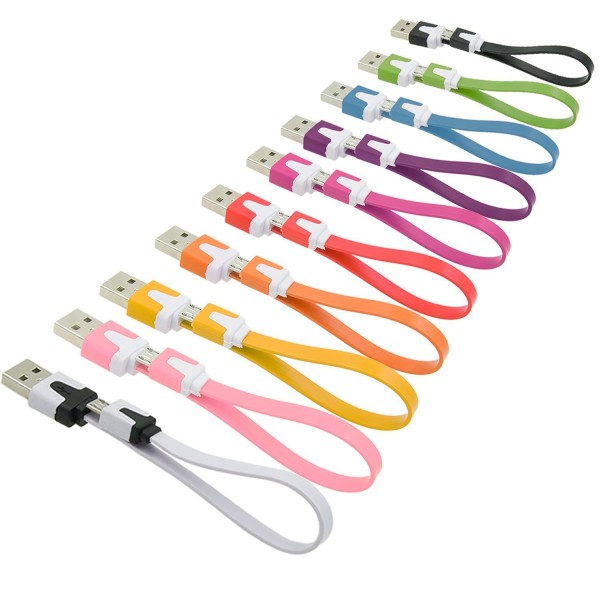
All frequent users of external battery banks often face situations when they have to extract every possible bit of power from their USB battery banks. It may be a long flight, or a long car drive, or a camping trip in the woods, or simply a bout of heavy gaming or music that leaves your phone and/or power bank battery threatening to quit.
Similarly, often people find that their bought power bank is not giving them the advertised or expected number of recharges. Often, this happens because most power bank users overlook a very important factor that determines how well their power bank will function – the USB recharge cable connecting their device to the power bank!
Here is an easy trick, mostly overlooked by many people, for maximizing the battery life of your power bank.
Use a short and high quality USB cable for charging your devices from the power bank to extract maximum power.
Or in other words, do not use long or poor quality cables for charging your devices from the external battery banks or power banks.
Why a short USB cable is much better than long cable
All cables, indeed all wires, have resistance to electricity. The way resistance works, the more the length of your cable the more will be its resistance. People often buy very long cables for charging their devices as longer cables offer better convenience. For example, longer cables often allow you to charge your device while it is in your hand and the power bank is in the bag or your pocket.
However, the bad news is that these extra long cables that can sometimes be 6-8 times the length of short charging cables also have 8 times (!!) the resistance of a short cable. As phones are charged with very low voltage current ( just 5 volts), this huge resistance becomes a big factor and causes a direct steep drop in the voltage reaching your phone. Long cables simply waste all the power coming from your power bank as heat along the length of the cable.
Our tests show that using a long charging USB cable instead of a short and high quality cable can decrease the effective charging capacity of your power bank by 30-60% depending on the length of the cable. In most of our tests, the shortest cables gave almost twice the number of recharges when compared to the longest cables.
For this very same reason, you will often notice that many quality power bank manufacturers ship only very short cables with the power banks as they know that the short cables are the best for charging with power banks.
That 6-feet long Lightning cable or micro-USB/USB-C cable you bought for its long reach is good when charging from the wall charger or power adapter but is simply not a good idea at all when charging your phone or tablet from your portable power bank.
We recommend using the shortest possible USB cables for charging your devices with portable chargers. In most cases, you will see an instant improvement in the number of recharges when switching to a short cable. 15-cm (six inches) is an optimum length for most charging requirements.
Also, if you are going to buy new short cables, then consider right-angle cables as right angle cables do not come out easily from the phones or power banks
For micro-USB Android phones, The CableCreation 6-inch (15-cm) cable or a 90-degree 6-inch micro-USB cable is a good example of a nice and quality cable for charging devices from power banks.
For USB-C Android phones, The CableCreation USB-C 6-inch (15-cm) cable or a Right-angle 18-inch USB-C cable with inbuilt 56k resistor for safety are a good choice for charging Samsung/LG/Moto USB-C phones from portable chargers.
For iPhones, then Apple MFi certified cables such as Ugreen 3 feet Right angle Lightning cable or Anker Powerline II Lightning 1-ft cable are excellent good short cables. Anker even has 4-inch Lightning cables for iPhones for maximum efficiency and minimum clutter.
If you do have to go long for some reason, then 3-feet is a good upper maximum limit as long as you are using a very high quality cable. Anything above that is just needlessly wasting power bank backup capacity.
Of course, another benefit of shorter cables is reduced clutter!
USB cable quality matters
Cable quality is also an important factor in determining the efficiency of your power bank. Copper is the best material for cable wires. However, pure copper is an expensive metal and do not simply assume that a cable will have quality copper wires. Many low-cost Chinese manufacturers do ship cables with aluminum and even steel wires! An aluminum wire USB cable will instantly drastically reduce your power bank capacity! A steel wire has four times the resistivity of copper and is almost useless as a charging cable. As most USB cables are fairly cheap, the best option is to spend few dollars extra and get a cable from a good and reputed manufacturer.
Voltage Boost is not a substitute for short and quality cables
Some latest power banks such as Anker Powercore 20100 and Anker Powercore+ series come with features to increase the voltage of the power bank according to the resistance of the cable. While this feature (called Voltage Boost by Anker) does address the problem of voltage drop and slow charging due to long cables, it does not stop wastage of power. In fact, due to the increased voltage the power bank draws even more power to charge the device and drains even more faster! So, the best option always is to use a short and quality cable.

This is greatly appreciated. People are always asking about power banks. In particular my mind is thinking of the Nintendo Switch and how people would test power banks but not mention cord length and quality. The upper range of inefficiency here (up to 60%) is jarring, to say the least.